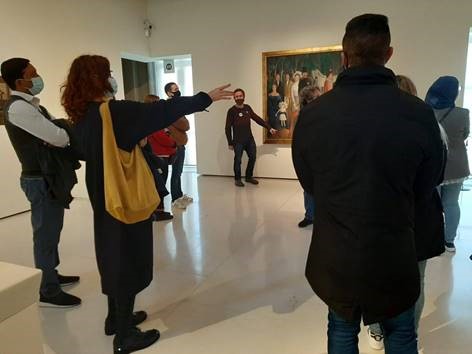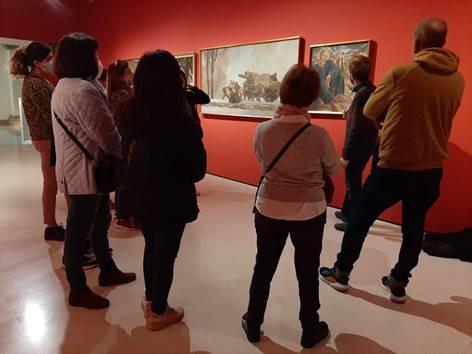Josep Maria Planas
A group of students stand in front of a painting in the museum, and after observing it for a while they begin talking about what they see, directed by their teacher, who this time changes his or her role for that of a facilitator.

The participants are making up stories, discovering enigmas, speculating about the clues that they see in the painting, listening to their fellow students’ hypotheses, agreeing, disagreeing, thinking … and they do so in a language that is not their own, as they are learning Catalan, Castilian or English in an academy for adults.
They seem to be having a very good time, and they are moreover participating actively in a key activity of the programme L’art de parlar (The Art of Speaking).
The Art of Speaking is an innovative programme arising from the collaboration between the Department ofEducation and the Museu Nacional d’Art de Catalunya to develop specific learning through art in the context of second languages at Adult Education centres.
A bit of history: where did the idea of promoting this programme come from?
In 2018, based on the initiative of the Lifelong Learning Service, contacts were established with the people in charge of the Museum’s Education Serviceto begin a pilot project to promote the improvement of oral skills in a foreign language at adult education centres through Visual Thinking Strategies (VTS). The successful experience of the Tàndem Schools Project conducted between the Museu Nacional d’Art de Catalunya and the Miquel Bleach School (now the Institut Escola Arts) was a referential model and it presaged a good commitment to educational improvement in adult colleges.
The main goal of the pilot project was to test the application of VTS in the language groups of adult education centres to monitor its impact on oral practice and the development of the participants’ communication skills, and on the competences related to linguistic practice (oral interaction) and the development of critical thinking and the ability to analyse and synthesize, among others.

Another goal was to co-create a sustainable language learning programme in adult education centres using, among others, the collections of the Museu Nacional d’Art de Catalunya and VTS methodology for two purposes: on the one hand, learning to significantly use the work of art and group discussion as tools to encourage language learning; on the other, to think about pedagogical practice in the teaching processes in language learning and the emotional, social and educational benefits derived from the use of the methodology.
The satisfactory results obtained during the pilot stage laid the foundations for the creation of the innovative programme The Art of Speaking, which was recognized by the Education Department on 12 June 2019.
What are the main ideas of the programme?

The programme envisages specific training in Visual Thinking Strategies (VTS) for teachers at the adult education centres taking part in it, but also exchanging experiences in order to share and improve methodologies, especially in the field of communication and visual literacy.
Esther Fuertes, who currently coordinates the Museum’s Department of Activities and Education, has headed the programme’s training team, with Montserrat Morales as an expert trainer in the methodology, and the collaboration of the museum’s team of educators.
If you would like to know more about the methodology, this article in the blog goes into detail about its origins and benefits: Les Estratègies de Pensament Visual (VTS), una metodologia educativa necessària
The application of this methodology may seem simple, but a VTS session is not a routine image interpretation exercise.
The group is standing in front of the work of art, and the teacher-facilitator asks three simple open questions about the work, and based on these questions the students observe, comment on what they see or what the work suggests to them and give reasons.
The teacher becomes a facilitator and has not previously anticipated what will come up in the discussion. There are no expectations about the discussions that will be generated or the lexis or the linguistic structures the students will use. The job of the facilitator, therefore, is to properly paraphrase what the participants say, thus supplying a model and providing correction when necessary. They may enrich the discourse but under no circumstances do they make contributions beyond what the students have said.

Without realizing, the students learn from one another and develop communication skills.
The teachers work with pairs of students; one acts as the facilitator and the other the observer alternately in the conversation the students establish to discuss the chosen works of art. This interaction and the subsequent coaching session encourage reflection and improvement of the teaching work.
The programme is flexible enough to be worked on at the different levels of language learning or in other areas of the adult learning centres’ educational syllabuses, according to their specific needs. In principle it is conducted in eight annual sessions distributed throughout language levels 2 and 3 (Catalan, Castilian and English), although a single initiation session is conducted at the end of level 1.
A visual curriculum proposed by Montserrat Morales is currently being piloted, composed of works in the Museu Nacional d’Art de Catalunya and many other works from other collections elsewhere, making it possible to hold three sessions at the museum each year.
Also up and running is a work group at the CFA Pere Calders that creates transverse teaching ideas related to the works in the visual curriculum in order to study the themes of the SDG in depth and incorporate elements of language work that may appear during the VTS discussions.
The Museum as an educational agent that enables the creation of networks
Training activities for year three and for those beginning this year are currently being combined for the centres in the programme. Besides the challenge of creating a network of centres to exchange experiences and learning, alliances with other local art centres and sponsorships between year three and beginners’ centres are also being created.

The dimension of the programme aims to create dynamics beyond the link with the Museu Nacional d’Art de Catalunya, as it has set up alliances between the different adult education centres in Catalonia and other local museums or arts centres with the aim of using their rooms for the VTS discussions with the students. The school, therefore, doubles up and incorporates new areas of learning that enable a connection with the cultural heritage nearest to it. This is undoubtedly an incentive for students, who often discover these spaces for the first time.
The Art of Speaking is a good example of how education can get close to the artistic heritage and how to democratize access to the cultural heritage, since it allows participants to have a personal and social view that goes beyond works of art and connects them to the world as citizens.
If you would like to join the programme or find out more details, don’t miss a new article with some tips for getting started. Let yourself be captivated by the art of speaking!
Josep Maria Planas
Key words: learning, art, VTS, the Art of Speaking, education, adults; visual thinking strategies
To know more:
- MNAC blog – Visual Thinking Strategies (VTS), a necessary educational methodology: https://blog.museunacional.cat/les-estrategies-de-pensament-visual-vts-una-metodologia-educativa-necessaria/
- Claustre Obert a la recerca educativa: L’art de parlar: l’art d’aprendre llengües: https://projectes.xtec.cat/claustreobert/general/lart-de-parlar/
- Descripció del projecte L’art de Parlar al CFA Pere Calders: https://cfaperecaldersvts.wordpress.com/
- Com va sorgir el programa?: https://cfaperecaldersvts.wordpress.com/historia/
- Document de presentació del pilotatge del programa (juny 2018): https://drive.google.com/file/d/18-32maL6ZiweG7sqxHU3ayZmRpyShNZ8/view
- Programa d’innovació educativa L’art de parlar (Web del Servei d’Educació al Llarg de la Vida): https://projectes.xtec.cat/xarxadults/programes/lart-de-parlar/ Document de presentació del programa L’art de parlar als CFA (2019-2020): https://drive.google.com/file/d/1L7YwWZonCY4caEVgY1SI7GEXfxqz9wvT/view
- RESOLUCIÓ EDU/1635/2019 del Programa d’innovació pedagògica L’art de parlar: https://dogc.gencat.cat/ca/document-del-dogc/?documentId=852228
Videos
- Education Department video Aprenem llengua a través de l’art al Museu Nacional d’Art de Catalunya: https://youtu.be/IObIh-hn8FA
- MNAC video El museu com espai d’aprenentatge (L’art de parlar at CFA Pere Calders): https://youtu.be/80LosmKxI0Q
- Webinar L’art de parlar: l’art d’aprendre llengües (CFA Pere Calders): https://youtu.be/YpChrC97Gmo
Centre de Formació d'Adults Pere Calders








One comment
[…] de Catalunya. Podeu llegir-lo en català (L’art de parlar), castellà (El arte de hablar) o anglès (The art of […]